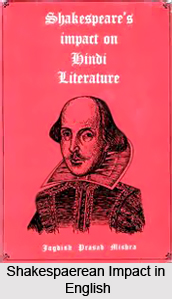 The emergence of Hindi literature can be traced back to as early as the 7th or 8th centuries. The dialect that has been chosen as the official language of India comprises of the Khari boli (Modern Standard Hindi) in the Devanagari script. Other dialects of Hindi include: Brajbhasa, Bundeli, Awadhi, Marwari, Maithili and Bhojpuri. The true aura of the Hindi literature was first appropriated in its poetry form and was essentially oral. The earliest works were composed for the purpose of singing or reciting and were thus transmitted for many generations, prior penning them down. Prose was a much later introduction to the Hindi literary scene. The first work of prose in Hindi is generally agreed upon as being the fantasy novel Chandrakanta by Devaki Nandan Khatri.
The emergence of Hindi literature can be traced back to as early as the 7th or 8th centuries. The dialect that has been chosen as the official language of India comprises of the Khari boli (Modern Standard Hindi) in the Devanagari script. Other dialects of Hindi include: Brajbhasa, Bundeli, Awadhi, Marwari, Maithili and Bhojpuri. The true aura of the Hindi literature was first appropriated in its poetry form and was essentially oral. The earliest works were composed for the purpose of singing or reciting and were thus transmitted for many generations, prior penning them down. Prose was a much later introduction to the Hindi literary scene. The first work of prose in Hindi is generally agreed upon as being the fantasy novel Chandrakanta by Devaki Nandan Khatri.
The historical evolvement of Hindi literature as a whole however can be divided into four stages, consisting of: Adi kal (the Early Period), Bhakti kal (the Devotional Period), Riti kal (the Scholastic Period) and, Adhunik kal (the Modern Period). Hindi literature however can also be broadly categorised into four distinguishing forms or styles, represented by Bhakti (devotional - with authors like Kabir, Raskhan); Shringar (beauty - with authors like Keshav, Bihari); Veer-Gatha (glorifying dauntless warriors); and Adhunik (modern).

Adi kal in Hindi literature began from the middle of the 10th century and made its curtain call in the beginning of the 14th century The Adi Kal or the early period in Hindi literature greatly matured in the states of Ajmer, Delhi , Kannauj and extended up to central India in present day modern Madhya Pradesh.
The medieval Hindi literature and its sufficient maturation were marked by the influence of Bhakti Movement and compilation of lengthy, epic poems. This has been marked as the Bhakti Kal or the Devotional Period in Hindi literature. The Bhakti kal or devotional period in Hindi literature also was accentuated by great theoretical development in poetry forms, predominantly from a blend of older forms of poetry in Sanskrit School and the Persian School. These included Verse Patterns like Doha (two-liners), Sortha, Chaupaya (four-liners), etc. This was also the epoch when Poetry was differentiated under the various Rasas. Right after the Bhakti kal it was the influence of the Riti kal in Hindi literature which made the literature further rich. The Riti kal or the scholastic period in Hindi literature spans the period beginning from 1600 A.D. and culminating in 1850 A.D.
Adhunik kal or the Modern Period in Hindi literature commenced in the middle of the 19th century. The most decisive evolution of this period was the germination of Khari boli prose and abundant use of this standard Hindi dialect in poetry instead of Braj bhasha. Modern Hindi literature has been divided into four phases, comprising: the age of Bharatendu or the Renaissance (1868-1893), Dwivedi Yug (1893-1918), Chhayavada Yug (1918-1937) and the Contemporary Period (1937 onwards).













